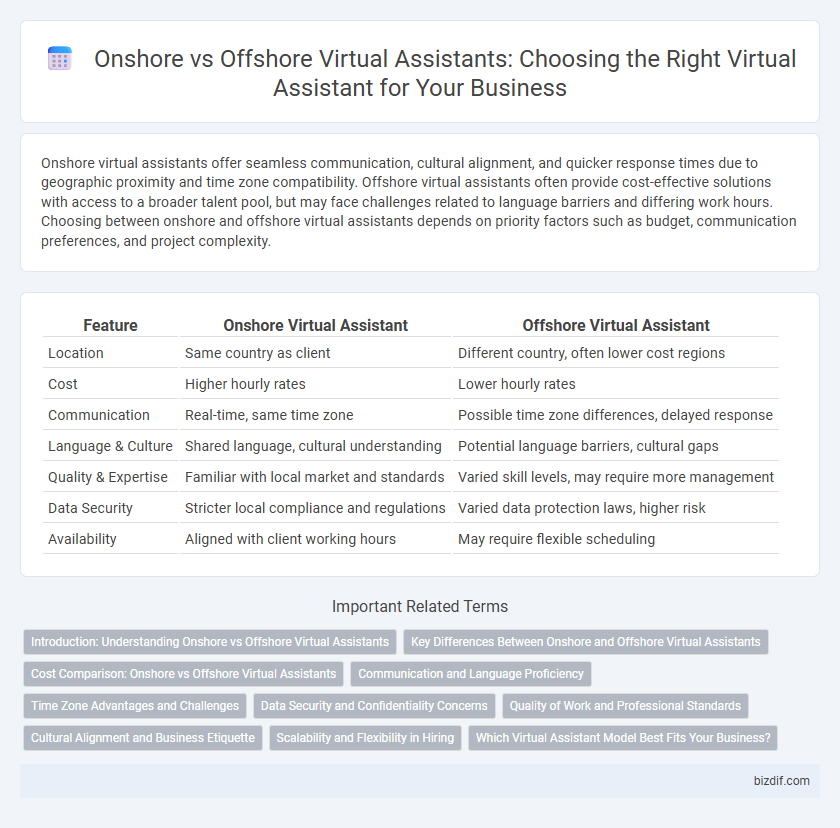Onshore virtual assistants offer seamless communication, cultural alignment, and quicker response times due to geographic proximity and time zone compatibility. Offshore virtual assistants often provide cost-effective solutions with access to a broader talent pool, but may face challenges related to language barriers and differing work hours. Choosing between onshore and offshore virtual assistants depends on priority factors such as budget, communication preferences, and project complexity.
Table of Comparison
| Feature | Onshore Virtual Assistant | Offshore Virtual Assistant |
|---|---|---|
| Location | Same country as client | Different country, often lower cost regions |
| Cost | Higher hourly rates | Lower hourly rates |
| Communication | Real-time, same time zone | Possible time zone differences, delayed response |
| Language & Culture | Shared language, cultural understanding | Potential language barriers, cultural gaps |
| Quality & Expertise | Familiar with local market and standards | Varied skill levels, may require more management |
| Data Security | Stricter local compliance and regulations | Varied data protection laws, higher risk |
| Availability | Aligned with client working hours | May require flexible scheduling |
Introduction: Understanding Onshore vs Offshore Virtual Assistants
Onshore virtual assistants operate within the same country as the client, providing seamless communication, cultural alignment, and time zone compatibility. Offshore virtual assistants are based in different countries, offering cost-effective solutions with potential challenges in language nuances and coordination. Understanding these differences helps businesses optimize productivity and manage operational costs effectively.
Key Differences Between Onshore and Offshore Virtual Assistants
Onshore virtual assistants provide services within the same country, ensuring seamless communication, cultural alignment, and compliance with local regulations, which enhances collaboration and efficiency. Offshore virtual assistants, typically based in countries with lower labor costs, offer cost-effective solutions but may face challenges related to time zone differences, language barriers, and varying quality standards. Businesses must weigh factors like budget, communication preferences, and project complexity when choosing between onshore and offshore virtual assistants to optimize productivity and operational outcomes.
Cost Comparison: Onshore vs Offshore Virtual Assistants
Onshore virtual assistants typically charge higher hourly rates, ranging from $25 to $50, due to local labor costs and regulations, whereas offshore virtual assistants can cost between $5 and $15 per hour, reflecting lower operational expenses in countries like the Philippines and India. Businesses seeking budget-friendly solutions often prefer offshore assistants, but onshore options may offer benefits in communication, time zone alignment, and cultural understanding. Evaluating the total cost of ownership should include factors like training, oversight, and potential delays caused by language barriers or time differences.
Communication and Language Proficiency
Onshore virtual assistants offer superior communication and language proficiency due to cultural alignment and native language fluency, ensuring clearer understanding and fewer misinterpretations. Offshore virtual assistants may present challenges in accent, idiomatic expressions, and real-time responsiveness, potentially impacting overall communication quality. Choosing onshore talent minimizes language barriers, enhancing collaboration efficiency and task accuracy.
Time Zone Advantages and Challenges
Onshore virtual assistants offer significant time zone advantages by aligning closely with a company's local business hours, enabling real-time communication and faster response times. Offshore virtual assistants often handle tasks outside standard local hours, providing extended operational coverage but may face challenges in synchronous collaboration due to significant time differences. Businesses must weigh the benefits of immediate availability against potential delays in coordination when choosing between onshore and offshore virtual assistant services.
Data Security and Confidentiality Concerns
Onshore virtual assistants offer enhanced data security and confidentiality due to stricter compliance with local regulations such as GDPR and CCPA, reducing risks of data breaches. Offshore virtual assistants may present challenges in protecting sensitive information because of varying international data protection laws and potential language barriers that can lead to miscommunication. Choosing an onshore virtual assistant ensures better control over data handling processes and aligns with organizational security policies.
Quality of Work and Professional Standards
Onshore virtual assistants typically provide higher quality of work and adhere to stricter professional standards due to closer cultural alignment and real-time communication capabilities. Offshore virtual assistants may offer cost advantages but often face challenges in maintaining consistent quality and meeting industry-specific professional benchmarks. Investing in onshore talent ensures better accountability, enhanced expertise, and compliance with local regulations, critical for maintaining brand reputation.
Cultural Alignment and Business Etiquette
Onshore virtual assistants typically offer stronger cultural alignment and familiarity with local business etiquette, fostering smoother communication and more efficient collaboration. In contrast, offshore virtual assistants may face challenges in understanding regional nuances, which can impact client interactions and project outcomes. Prioritizing a virtual assistant with compatible cultural values and professional practices enhances productivity and reduces misunderstandings.
Scalability and Flexibility in Hiring
Onshore virtual assistants offer greater scalability and flexibility in hiring due to proximity, easier communication, and alignment with local business hours, enabling faster onboarding and adjustment to changing workload demands. Offshore virtual assistants provide cost-effective scalability with access to a larger talent pool but may face challenges in time zone differences and communication barriers that impact flexibility. Businesses seeking rapid expansion and dynamic team adjustments often balance both options to optimize scalability and flexibility in virtual assistant hiring.
Which Virtual Assistant Model Best Fits Your Business?
Choosing between an onshore virtual assistant and an offshore virtual assistant depends on factors like communication preferences, time zone alignment, and budget constraints. Onshore virtual assistants offer direct cultural alignment and real-time collaboration, ideal for tasks requiring nuanced understanding and immediate feedback. Offshore virtual assistants provide cost-effective solutions with access to a broader talent pool, making them suitable for scalable, routine, and non-time-sensitive assignments.
Onshore virtual assistant vs Offshore virtual assistant Infographic

 bizdif.com
bizdif.com